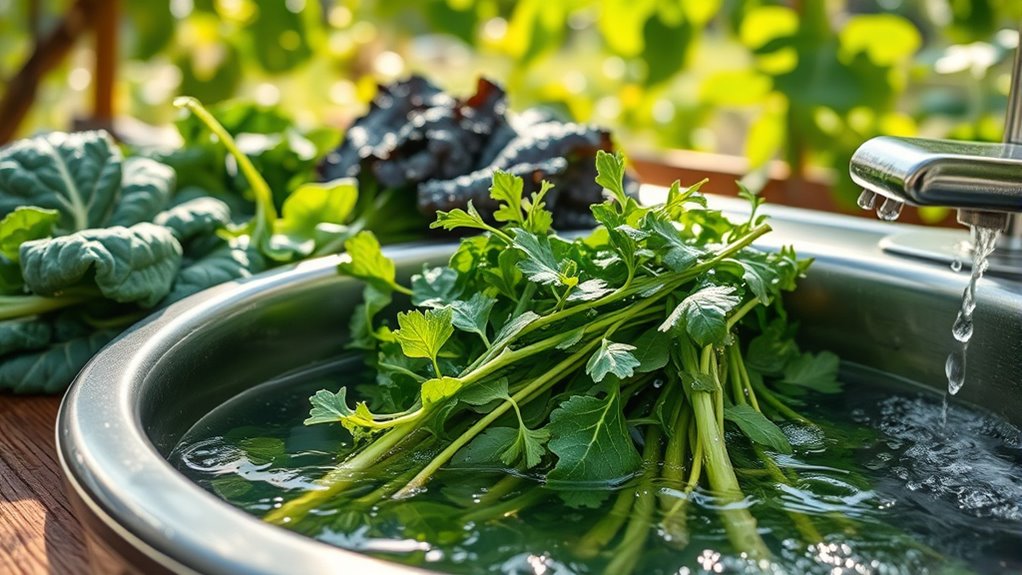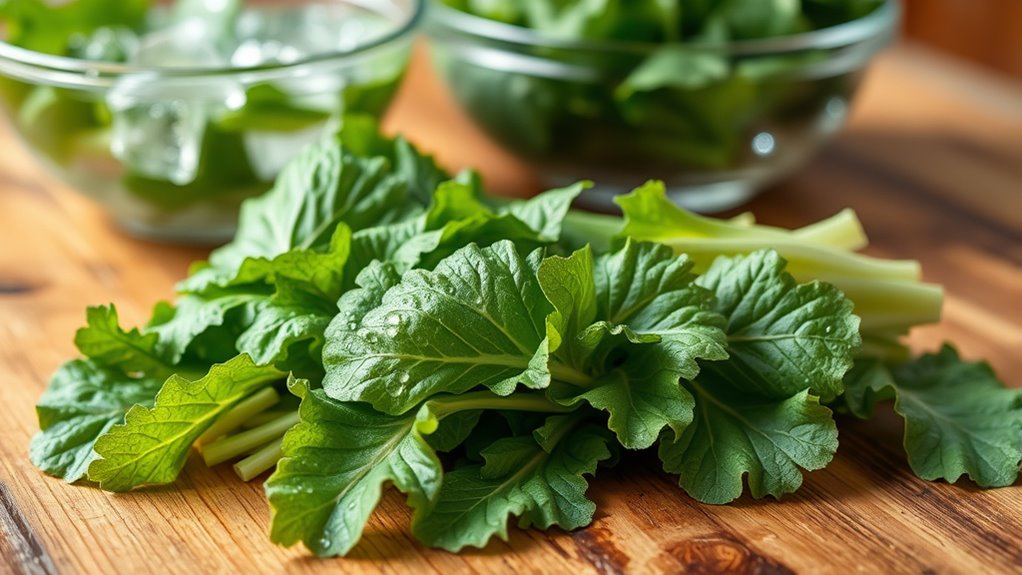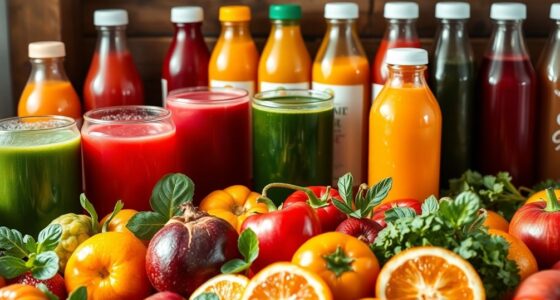To make the best organic greens juice, choose vibrant, crisp leaves from local farms or certified sources, ensuring they’re fresh and seasonally ripe. Wash them thoroughly under cold, running water or soak in a vinegar solution to remove dirt, bacteria, and pesticide residues. Proper handling and cleaning preserve nutrients and improve safety. If you want tips on selecting and prepping greens for maximum flavor and nutrition, keep exploring these simple but effective steps.
Key Takeaways
- Source greens from local farms to ensure peak ripeness and maximum nutrient content.
- Choose vibrant, fresh, and crisp greens with minimal wilting or browning for optimal quality.
- Look for labels indicating local sourcing or organic certification to confirm quality standards.
- Rinse greens under cold, running water or soak in a vinegar solution to remove dirt, bacteria, and pesticide residues.
- Proper washing and handling preserve nutrients and safety, reducing chemical residues before juicing.

Have you ever wondered how to boost your daily nutrient intake effortlessly? One simple way is by including organic greens juice in your diet. But to truly maximize its health benefits, it’s essential to pay attention to how you source and prepare your greens. When shopping for greens, choosing local sourcing options can make a significant difference. Local farms often prioritize fresh, seasonal produce, which means your greens are likely to be harvested at peak ripeness, preserving more nutrients. Additionally, buying locally reduces the time between harvest and your table, ensuring you get the freshest greens possible. This not only enhances flavor but also minimizes the need for preservatives or extensive handling that can diminish nutrient quality.
However, even when opting for organic greens, you should remain cautious about pesticide residues. Organic doesn’t mean pesticide-free in all cases, but it generally involves fewer synthetic chemicals. Still, some farms might use natural pesticides or other approved substances that can leave residues on produce. To protect yourself, always wash your greens thoroughly before juicing. Rinsing under cold, running water helps remove dirt, bacteria, and surface residues, including any traces of pesticides. For added safety, you can use a vinegar solution—mix one part vinegar to three parts water—to soak your greens for a few minutes, then rinse thoroughly. This practice helps break down residues and reduces potential contaminants. Proper washing techniques are essential for maintaining the highest quality and safety of your greens.
When selecting greens, look for vibrant, crisp leaves with no signs of wilting or browning. Avoid greens with visible dirt or sliminess, which can harbor bacteria. If possible, choose greens that come with a label indicating they’re locally sourced or certified organic, giving you extra confidence in their quality. Remember, the goal is to minimize exposure to unwanted chemicals while maximizing nutrient intake. Local sourcing, combined with proper washing, ensures you’re getting the freshest, most nutrient-dense greens for your organic greens juice.
Preparing your greens with care not only impacts your health but also supports sustainable farming practices. By prioritizing local, organic produce and washing thoroughly, you’re making a conscious choice to enjoy all the benefits of organic greens juice. It’s a simple step that can boost your health, reduce exposure to harmful residues, and support your local community. With these tips, you can confidently incorporate delicious, nutrient-packed greens into your daily routine, knowing you’re doing your part for both your health and the environment.
Frequently Asked Questions
How Long Can Organic Greens Juice Be Stored Safely?
You can typically store organic greens juice safely for up to 48 hours if kept in an airtight container in the fridge. To guarantee maximum freshness preservation, drink it as soon as possible after juicing. After this period, the juice may lose nutrients and develop off flavors or spoilage. Always check for any signs of fermentation or bad odor before consuming, and when in doubt, discard it.
Are There Specific Organic Greens Varieties Best for Juicing?
Did you know that choosing the right greens can boost your nutrient intake by up to 50%? When selecting greens for juicing, opt for varieties like kale, spinach, and arugula, as they’re rich in vitamins and mild in flavor. Your greens selection greatly impacts taste and nutrition, so prioritize fresh, organic options. Juicing varieties like Swiss chard and romaine also work well, offering diverse flavors and health benefits.
Can I Grow My Own Greens for Juicing at Home?
Yes, you can grow your own greens for juicing at home. Start by setting up a home gardening space with organic gardening supplies like compost and natural fertilizers. Choose fast-growing, nutrient-dense greens like kale, spinach, or arugula. Regular watering and proper sunlight help guarantee healthy plants. Growing your own greens not only guarantees freshness but also allows you to enjoy organic, pesticide-free ingredients for your juices.
What Are Common Pests Affecting Organic Greens?
You’ll face pests that seem like tiny invaders trying to conquer your greens—aphids, caterpillars, and flea beetles are common culprits. These pests can cause a massive pest infestation if unchecked. Use organic pest control methods like neem oil, insecticidal soap, and companion planting to keep your greens healthy and safe. Regular monitoring and natural remedies will protect your crops without harmful chemicals, ensuring your greens stay pure and pristine.
How Do I Tell if Organic Greens Are Truly Pesticide-Free?
You can tell if organic greens are truly pesticide-free by checking for organic certification labels on the packaging, which guarantee the greens meet strict standards. Additionally, consider using pesticide test kits at home for extra assurance, as they detect residual pesticides. Always buy from trusted sources, and research their certification process to confirm they adhere to organic practices, giving you confidence in your greens’ purity.
Conclusion
By choosing organic greens, you’re planting the seeds of health and sustainability. Washing them thoroughly is like watering your intentions—cleansing impurities to reveal their pure vitality. When you juice these vibrant greens, you’re nurturing not just your body but also the earth’s well-being, symbolizing growth and renewal. Every sip becomes a reminder that your choices can cultivate a healthier future, turning simple greens into a powerful act of harmony between you and nature.










